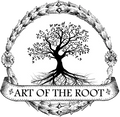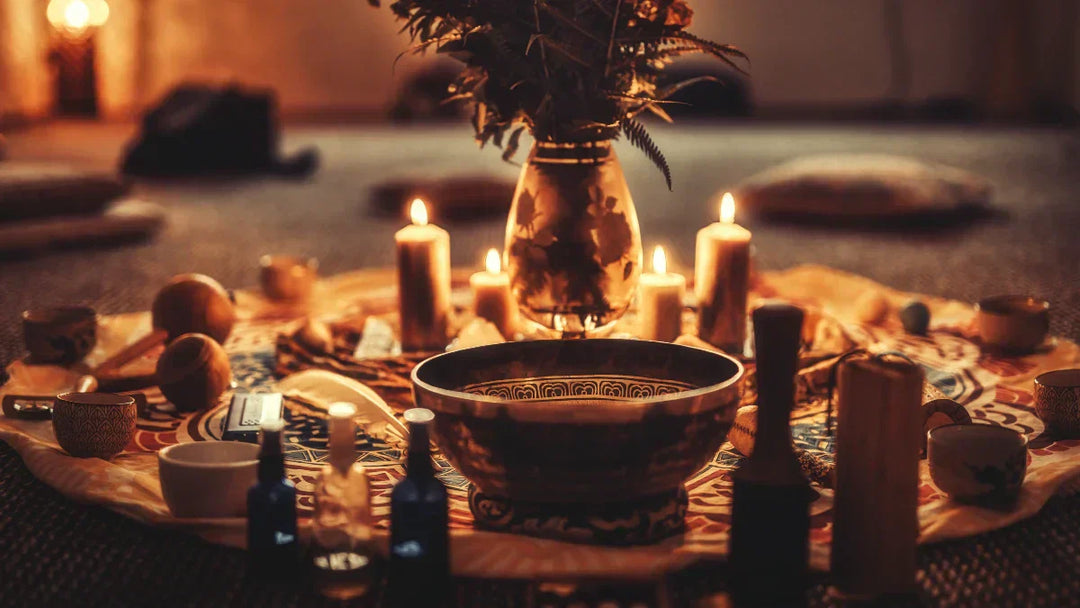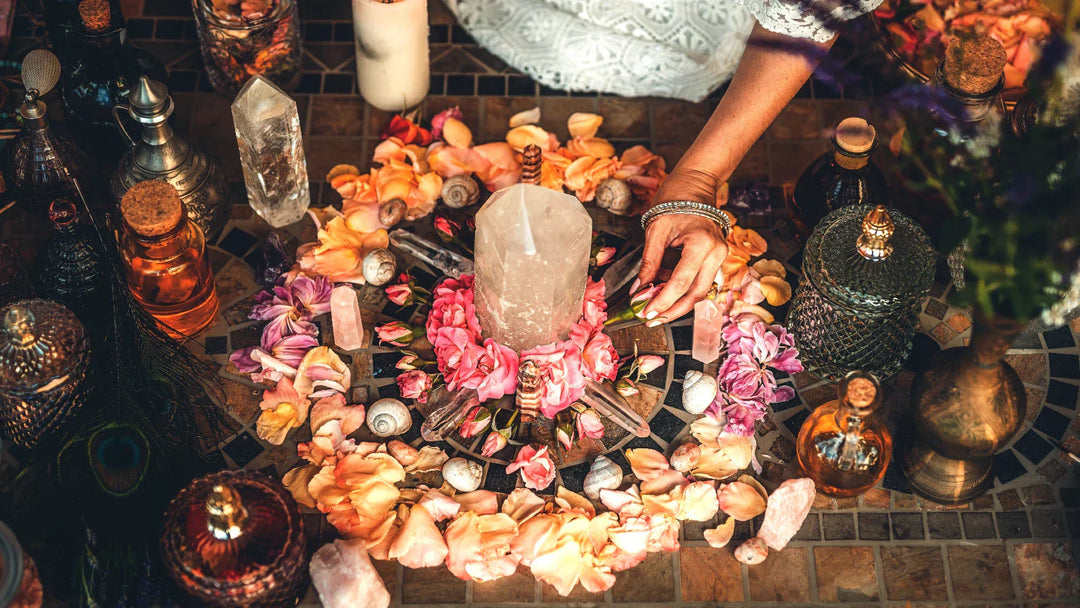Mullein, a plant with tall, flowering spikes and soft, velvety leaves, has long been revered for its medicinal and magical properties. Its history is rich with lore and legend, spanning across cultures and centuries. In this article, we will delve into the fascinating history of mullein, its modern associations, and its magical properties, culminating with a love spell that invokes the power of Hecate.
History and Folklore of Mullein

Mullein's storied past is steeped in myth and folklore, providing a glimpse into the plant's enduring significance. In ancient Greece, mullein was revered as a gift from the gods. Mercury, the messenger god, gave Ulysses mullein to protect him from Circe's magic, illustrating its long-standing association with divine protection and warding off evil. This myth highlights the plant's role as a guardian against malevolent forces, a theme that recurs throughout history.
In medieval Europe, mullein's protective qualities were well recognized. Grieve's A Modern Herbal mentions that mullein was believed to drive away evil spirits, a reputation that has persisted through the ages. It was often hung in doorways or burned as an incense to keep homes safe from negative energies (Watts, 2007). The use of mullein as a candle wick further solidified its protective symbolism. Known initially as "Hedge Taper," Roman soldiers used mullein wicks in their lamps, associating the plant with courage and bravery. Over time, the name evolved to "Hag Taper," reflecting its use by witches in their spells and rituals. These leaves and stems were dipped in tallow to create candles for outdoor ceremonies, emphasizing its role in bringing light to darkness (Kaldera, 2010).
Mullein was also integral to funeral rites in ancient Rome and medieval Europe. Its presence in these ceremonies symbolized light and guidance for the deceased in the afterlife. Monasteries grew mullein for its protective properties, as noted by Beyerl (1998). The plant was believed to shield the monastic communities from harm and negative influences, underlining its sacred and protective nature.
In America, mullein found a unique role in love divination. Practitioners used its leaves in rituals to reveal the identity of future lovers or ensure fidelity, showcasing its versatility in both protective and romantic contexts. This tradition added another layer to mullein's rich folklore, blending European and Native American beliefs.
Thus, mullein's history is a tapestry of protective, healing, and divinatory uses, woven through various cultures and eras. Its enduring presence in myth and folklore underscores its significance as a powerful and versatile herb in magical practices.
Mullein and it's Modern Association with Hecate
Mullein's association with the goddess Hecate is a natural extension of its historical uses and symbolism. Hecate, the goddess of witchcraft, magic, and crossroads, is often depicted with torches, illuminating the darkness. Mullein's use as a candle wick and its role in protective and magical practices align it with Hecate's domains. The plant's ability to provide light in dark places, both physically and metaphorically, resonates deeply with Hecate's role as a guide through the shadows. Furthermore, mullein's protective qualities and its use in various magical traditions, including those involving the dark arts, make it a fitting herb to be associated with this powerful goddess. In rituals invoking Hecate, mullein can serve as a symbolic link to her illuminating and protective energies, enhancing the effectiveness of the spellwork.
The Magical Properties of Mullein

Beyond its rich historical and folkloric significance, mullein boasts a myriad of magical properties that have been revered and utilized by practitioners for centuries. From its protective attributes to its roles in courage, love divination, healing, and banishing evil spirits, mullein serves as a versatile and powerful herb in the magical realm. We use it in a number of our conjure oils including our Reversing Oil and Hecate Oil, but it's versatile uses makes it a powerful ingredient for a number of intentions. Let's explore the diverse ways in which mullein can be harnessed to enhance various aspects of spiritual and magical practices.
Protection
Mullein's protective qualities are well-documented in various magical traditions. The soft, velvety leaves of the mullein plant are often stuffed into pillows to prevent nightmares and ensure a restful sleep, free from negative influences. This practice is particularly effective for children or those prone to night terrors. Additionally, mullein is planted near homes to create a barrier against evil spirits and malevolent forces. Its tall, sturdy stalks are believed to ward off unwanted energies, making it a staple in protective gardening.
Substitution for Graveyard Dust
In many Afro-American magical traditions, also known as Hoodoo or Rootwork, graveyard dust is a common ingredient used in spells for protection, cursing, and spirit communication. Mullein, with its similar properties, can be used as a substitute for graveyard dust when it is unavailable or when a less intense ingredient is desired (Yronwode, 2002). Mullein's versatility makes it a practical and effective replacement, maintaining the integrity of the spell while providing a more accessible option.
Courage
Historically, mullein has been associated with courage and bravery, particularly due to its use by Roman soldiers. To invoke courage, mullein can be placed in one's shoes or used in a bath. The herb's energy is believed to infuse the wearer or bather with strength and fortitude, making it ideal for situations that require confidence and boldness.
Love and Divination
Mullein's role in love divination has been particularly noted in American folk practices. Its leaves are used in rituals to reveal the identity of a future lover or to ensure fidelity in a relationship. Additionally, mullein is employed in divination rituals to enhance the practitioner's ability to communicate with spirits and receive divine messages. This makes it a valuable herb for those seeking guidance in love matters or attempting to connect with the spiritual realm.
Healing
Mullein is renowned for its healing properties, both in physical and metaphysical practices. It is often stuffed into poppet dolls, which are used in sympathetic magic to promote health and recovery. The poppets are crafted to represent the person in need of healing, and the mullein inside works to restore vitality and well-being. Additionally, mullein can be used in healing spells, such as teas or infusions, to aid in respiratory issues and soothe inflammation, demonstrating its dual functionality in both herbalism and magic.
Banishing Evil Spirits
In addition to its protective capabilities, mullein is also used to banish evil spirits. This makes it a powerful tool in purification rituals, where it can be burned as an incense or used in a cleansing bath to drive away negative entities. The herb's strong protective energy ensures that spaces and individuals remain free from harmful influences, reinforcing its reputation as a versatile and potent magical ally.
A Love Spell with Mullein to Invoke Hecate

Hecate, the goddess of witchcraft and crossroads, is a powerful figure in love magic due to her ability to traverse the boundaries between worlds and illuminate hidden paths. By invoking Hecate, practitioners can remove obstacles and open new avenues in their romantic pursuits, ensuring that the love they attract is both genuine and enduring.
What You Need:
- Mullein leaves
- Lavender
- Myrrh
- 1 White Candle for burning
- 1 Red Candle for melting into wax
- A Key
- A cup of red wine
- A cauldron or something fire-safe to melt wax into
- A bouquet of flowers
- A piece of chalk
To perform a love spell with mullein invoking Hecate, begin by preparing your herbal mixture. Combine mullein, lavender, and myrrh, and powder them together until you have a fine blend. Next, using a piece of chalk, draw a cross on your altar or any surface you choose, representing a crossroads. Place a cauldron in the center of this cross. Arrange a key, a white candle, and a bouquet of flowers around the cauldron, creating a sacred space for your ritual.
Melt the red candle wax and allow it to cool until it is slightly warm but still moldable. At this point, mix in a pinch of your powdered herbal mixture. Once the herbs are fully incorporated into the wax, shape the wax into an image of your love interest, infusing it with your intentions and desires.
To invoke Hecate, begin by lighting the white candle. As the flame flickers to life, recite the invocation:
"I call the beloved goddess of roads And places where three ways meet. Heavenly, Earthly, and in the sea, saffron-cloaked goddess of graves, I pray to you maiden to attend these rites, Always with a kind heart to your Oxherd."
Next, take the wax figure you molded and focus on its chest area as you burn it. As the flame begins to consume the figure, recite:
"As this wax melts by light in the dark, So too does the heart of [Name of your Love Interest] melt for me. May his heart feel no peace until it meets mine In love and in union."
There is no need to completely melt the figure, as this can be done later if you wish to break the spell.
Afterward, express your gratitude to Hecate, speaking sincerely from your heart. Allow the white candle to burn down completely, symbolizing the completion of your ritual. Keep the altar set up until the flowers begin to wilt. When this happens, take all the items used in the ritual to a graveyard and bury them, sealing the spell.
For more on the magical spells, check out our blog article, Kitchen Witchery for Love, Abundance and Healing
References
Beyerl, P. V. (1998). A compendium of herbal magick. Phoenix Pub.
Dunn, P. (2018). The Orphic hymns: A new translation for the occult practitioner. Llewellyn Publications.
Kaldera, R. (2010). The Northern shamanic herbal. Asphodel Press.
Watts, D. (2007). Dictionary of plant lore. Elsevier/AP.
Collins, David J. The Cambridge History of Magic and Witchcraft in the West: From Antiquity to the Present. Cambridge University Press, 2018.
Yronwode, Catherine. Hoodoo Herb and Root Magic: A Materia Magica of African-American Conjure and Traditional Formulary, Giving the Spiritual Uses of Natural Herbs, Roots, Minerals, and Zoological Curios. Lucky Mojo Curio Co, 2002.






Leave a comment